Andrija Petrovic
Incorporating LLM Priors into Tabular Learners
Nov 20, 2023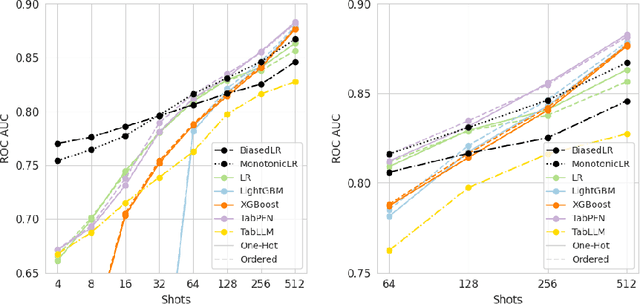
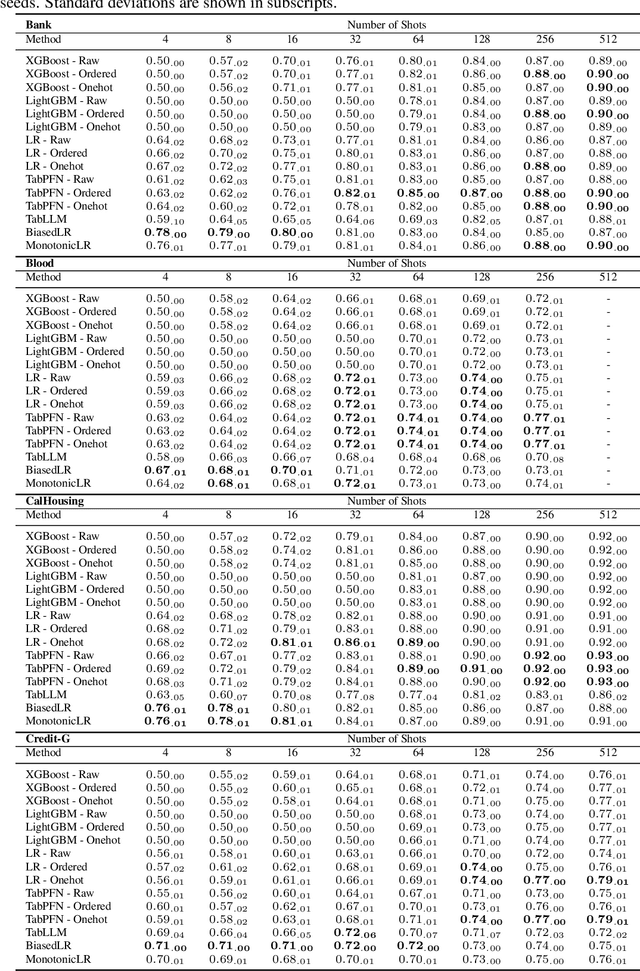
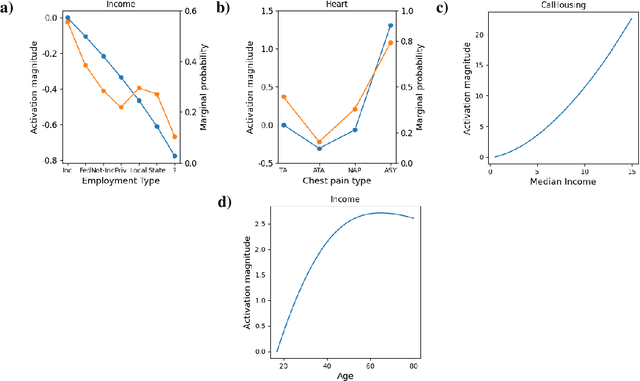
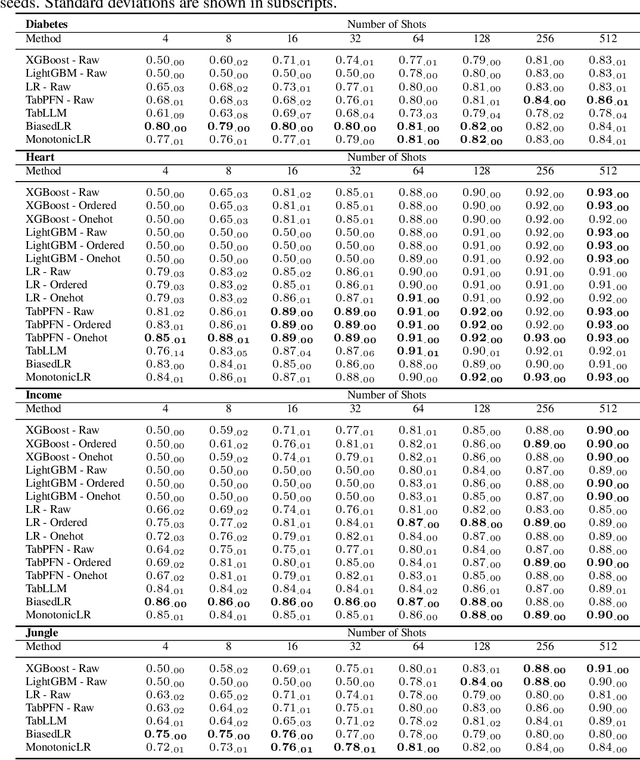
Abstract:We present a method to integrate Large Language Models (LLMs) and traditional tabular data classification techniques, addressing LLMs challenges like data serialization sensitivity and biases. We introduce two strategies utilizing LLMs for ranking categorical variables and generating priors on correlations between continuous variables and targets, enhancing performance in few-shot scenarios. We focus on Logistic Regression, introducing MonotonicLR that employs a non-linear monotonic function for mapping ordinals to cardinals while preserving LLM-determined orders. Validation against baseline models reveals the superior performance of our approach, especially in low-data scenarios, while remaining interpretable.
Tabular Few-Shot Generalization Across Heterogeneous Feature Spaces
Nov 16, 2023Abstract:Despite the prevalence of tabular datasets, few-shot learning remains under-explored within this domain. Existing few-shot methods are not directly applicable to tabular datasets due to varying column relationships, meanings, and permutational invariance. To address these challenges, we propose FLAT-a novel approach to tabular few-shot learning, encompassing knowledge sharing between datasets with heterogeneous feature spaces. Utilizing an encoder inspired by Dataset2Vec, FLAT learns low-dimensional embeddings of datasets and their individual columns, which facilitate knowledge transfer and generalization to previously unseen datasets. A decoder network parametrizes the predictive target network, implemented as a Graph Attention Network, to accommodate the heterogeneous nature of tabular datasets. Experiments on a diverse collection of 118 UCI datasets demonstrate FLAT's successful generalization to new tabular datasets and a considerable improvement over the baselines.
Reimagining Synthetic Tabular Data Generation through Data-Centric AI: A Comprehensive Benchmark
Oct 25, 2023Abstract:Synthetic data serves as an alternative in training machine learning models, particularly when real-world data is limited or inaccessible. However, ensuring that synthetic data mirrors the complex nuances of real-world data is a challenging task. This paper addresses this issue by exploring the potential of integrating data-centric AI techniques which profile the data to guide the synthetic data generation process. Moreover, we shed light on the often ignored consequences of neglecting these data profiles during synthetic data generation -- despite seemingly high statistical fidelity. Subsequently, we propose a novel framework to evaluate the integration of data profiles to guide the creation of more representative synthetic data. In an empirical study, we evaluate the performance of five state-of-the-art models for tabular data generation on eleven distinct tabular datasets. The findings offer critical insights into the successes and limitations of current synthetic data generation techniques. Finally, we provide practical recommendations for integrating data-centric insights into the synthetic data generation process, with a specific focus on classification performance, model selection, and feature selection. This study aims to reevaluate conventional approaches to synthetic data generation and promote the application of data-centric AI techniques in improving the quality and effectiveness of synthetic data.
Interpretable Medical Diagnostics with Structured Data Extraction by Large Language Models
Jun 08, 2023



Abstract:Tabular data is often hidden in text, particularly in medical diagnostic reports. Traditional machine learning (ML) models designed to work with tabular data, cannot effectively process information in such form. On the other hand, large language models (LLMs) which excel at textual tasks, are probably not the best tool for modeling tabular data. Therefore, we propose a novel, simple, and effective methodology for extracting structured tabular data from textual medical reports, called TEMED-LLM. Drawing upon the reasoning capabilities of LLMs, TEMED-LLM goes beyond traditional extraction techniques, accurately inferring tabular features, even when their names are not explicitly mentioned in the text. This is achieved by combining domain-specific reasoning guidelines with a proposed data validation and reasoning correction feedback loop. By applying interpretable ML models such as decision trees and logistic regression over the extracted and validated data, we obtain end-to-end interpretable predictions. We demonstrate that our approach significantly outperforms state-of-the-art text classification models in medical diagnostics. Given its predictive performance, simplicity, and interpretability, TEMED-LLM underscores the potential of leveraging LLMs to improve the performance and trustworthiness of ML models in medical applications.
MoËT: Interpretable and Verifiable Reinforcement Learning via Mixture of Expert Trees
Jun 16, 2019
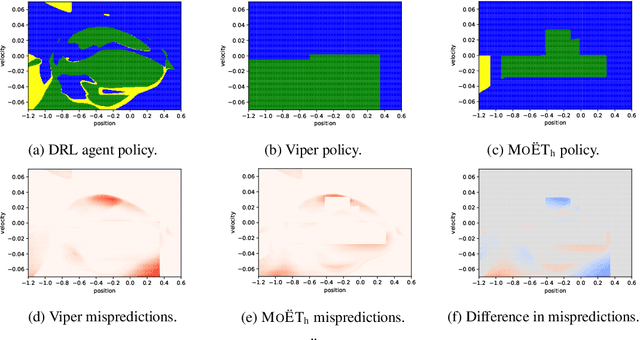

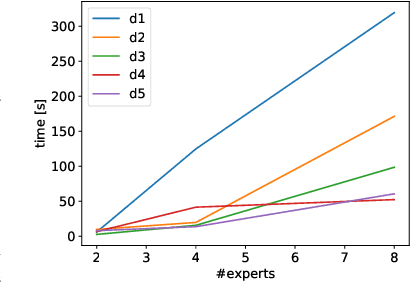
Abstract:Deep Reinforcement Learning (DRL) has led to many recent breakthroughs on complex control tasks, such as defeating the best human player in the game of Go. However, decisions made by the DRL agent are not explainable, hindering its applicability in safety-critical settings. Viper, a recently proposed technique, constructs a decision tree policy by mimicking the DRL agent. Decision trees are interpretable as each action made can be traced back to the decision rule path that lead to it. However, one global decision tree approximating the DRL policy has significant limitations with respect to the geometry of decision boundaries. We propose Mo\"ET, a more expressive, yet still interpretable model based on Mixture of Experts, consisting of a gating function that partitions the state space, and multiple decision tree experts that specialize on different partitions. We propose a training procedure to support non-differentiable decision tree experts and integrate it into imitation learning procedure of Viper. We evaluate our algorithm on four OpenAI gym environments, and show that the policy constructed in such a way is more performant and better mimics the DRL agent by lowering mispredictions and increasing the reward. We also show that Mo\"ET policies are amenable for verification using off-the-shelf automated theorem provers such as Z3.
 Add to Chrome
Add to Chrome Add to Firefox
Add to Firefox Add to Edge
Add to Edge